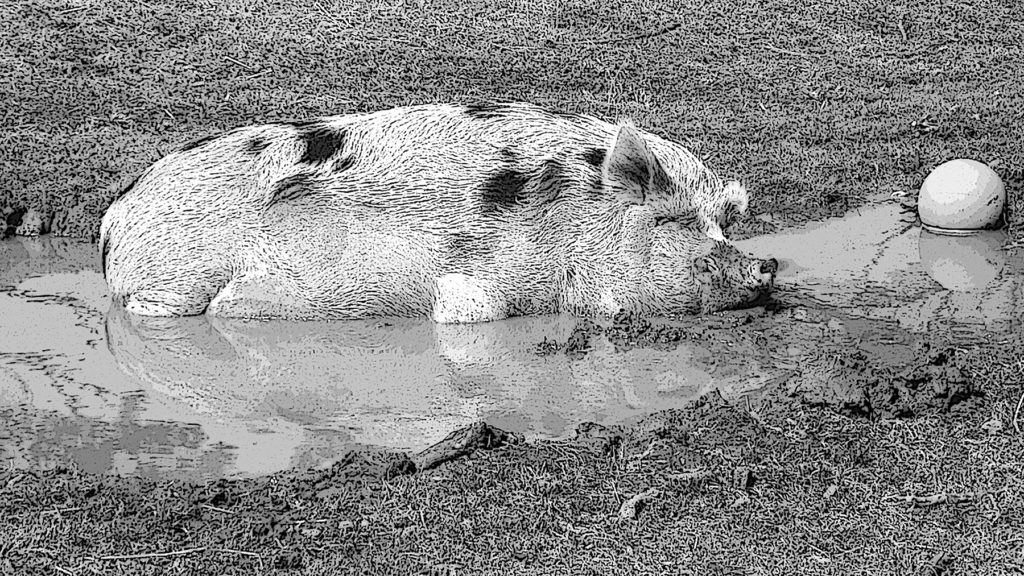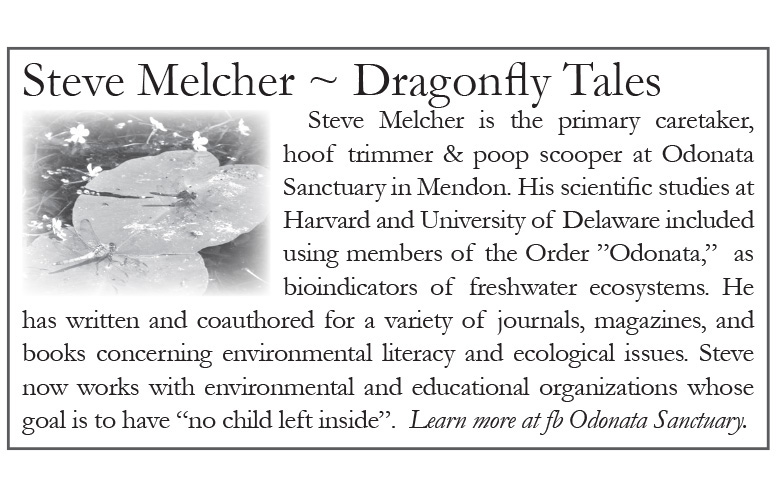Dragonfly Tales: Charlotte and Wilbur: The Odd Couple of Piggydom
– by Steve Melcher –

Required skills:
• Sit •Come/Recall •Stay •Leave it/Out/Back •Gentle Treat Taking •Harness & Leash •Stairs/Ramps •Walking in crowds •Accepting of Touch to Body
Other requirements:
•Your pig must be spayed/neutered.
•You must complete the course to qualify for certification. You will hold Therapy-Pet -in-Training status until you have completed all the requirements.
•Pigs under 1 year will be certified as Therapy-Pets-in-Training upon completion of the program and may resubmit at 1 year of age to become a certified Therapy Pet.
A visitor recently suggested that we train our pigs to become ‘helper animals’. See above for the requirements for a pig to become a therapy, emotional support, or service pig. Charlotte and Wilbur can do all of these. Not necessarily when anyone asks them to. They are perfectly capable of sitting and staying but seem to prefer eating and sleeping. Although the American Mini Pig Association has a rigorous training program, I think Charlotte and Wilbur are far too comfortable where they are here at Odonata Sanctuary and might not want to be sent to bovine boot camp. They seem to be perfectly happy in their porcine playground of piggy pleasures. Charlotte just turned 15 and Wilbur will be 17 in January. That’s 74 and 82 in human years. These two are the most intelligent critters at the sanctuary, followed closely by Joey and my son Rowan. Maybe you can teach an old pig new tricks, but at this point in their lives, I’m just happy to see them getting up from the mud and making their way back to the barn.
What are Mini-Pigs
Most of us have seen those cute smallish pigs with the beer belly swaying beneath them as they waddle along. Most of these pigs can be traced back to a fellow named Keith Connell who imported a few from Canada in the mid 80’s. These first mini pigs were imported for zoos but soon caught the attention of folks who wanted something a little different. In America, where a buck is to be made with a buck and a doe or in this case, a sow and a boar, folks were soon breeding and selling mini porkers as quickly as Don Juan Chorizo sausages sell on a street corner in NYC. These first mini pigs were relatively large, all black, wrinkled, particularly around the face and are usually referred to as the foundation stock. Keith named them the “Con Line”; perhaps a double entendre. However, shortly after the original importation, at least two other “breed types” were brought into U.S.; the Lea Line” imported by Leavitt (gentle disposition, white and black markings, somewhat smaller) and the Royal, imported by Espberger (mostly white, somewhat larger than the Lea Line). In fact, these pigs, Con, Lea and Royal represent most of the foundation stock found in America today. Except…in Wilbur’s case. Wilbur is the result of a cross between a minipig, probably a Lea, and a regular farm pig. Farm pigs can average 500-700 lbs. The largest recorded pig, FYI, was a Poland China breed of hog that tipped the scales at 2,552 lb (1,157 kg). Luckily, Wilbur, was not bred with ‘Big Bill’ as he was known. But, Wilbur does come in at around 400 pounds. An average mini pig, like Wilbur’s companion, Charlotte, weighs an average of 50 lbs, but may tip the scale at 200 lbs. Wilbur is not a minipig. One story that came with Wilbur, whose original name was Ludo (from Labyrinth fame), is that he was the result of a mini pig breeder who ran out of female breeder minis so she mated one of her mini-males to a full size farm sow. When folks came around to purchase the minipigs at $200 a pop, she would keep the mama sow out in the barn and separate the piglets. No one could tell the piglets weren’t minis….until a few weeks later. Most of the minipigs were living in folks homes, scratching at the door like a dog to go out and poop, being walked around like a little puppy or even attending Piggy Parties with other Pot Bellied Pigs. Wilbur, aka Ludo, was sold and lived very comfortably in a large house owned by a well known car dealer. Yes, Wilbur even appeared in a few TV commercials back in the day. But then Wilbur got to be too large for the house and would no longer fit in the car. The car dealer moved Wilbur outside to the pool house. Wilbur wouldn’t eat, lost weight and became ‘forlorn and lethargic’. To her credit, the car dealer, pig purchaser, found Wilbur a friend named Charlotte. Charlotte was purchased at a local ‘pet store’, something we discourage whether it’s a pig, a pup, a python or a pallas cat. There are plenty of critters out there that need a good home, and your local humane society is a wonderful place to find someone to care for. We’re glad Wilbur has Charlotte. The original owner found a nice farm for the two pigs but the farmer’s health soon declined and Wilbur and Charlotte needed to find a new home. The farmer offered the two to Lollypop Farm where we found them over 10 years ago. They don’t get around much anymore in their golden years, but they snuggle in the Piggy Cave, thankful to have someone to spoon with on cold winter nights. They both cuddle and exchange snores under a sign that Charlotte made that says ‘Some Pig’.
Vietnamese Pot-bellied (Sus scrofa domesticus)
Vietnamese Pot-bellied is the exonym for the Lon I , or I pig, an endangered traditional Vietnamese breed of small domestic pig. The Lon I pig is also known as the ‘I’ pig, which would make a great movie title: ‘I Pig’ (maybe a cross between ‘I Robot’ and ‘Animal Farm’. The I pig is considered an invasive species in Spain. Release of the Vietnamese pot-bellied into the wild, possession, transport and commerce of the breed are forbidden. Small numbers of I pigs were exported in the 1960s to Canada and Sweden, to be kept in zoos or to be used for laboratory experiments. Within a decade, the I had spread to animal parks in other countries in Europe; a few were reared on small farms. The I entered the United States from Canada in the mid-1980s as mentioned above, and by the end of the decade the “pot-bellied pig” was being marketed as a pet. Not all of these were purebred, and some grew to considerable size; the fad was short-lived and as a result sanctuaries are filled with companionless cob rollers.
